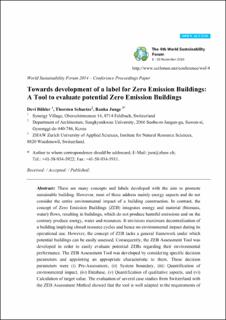Please use this identifier to cite or link to this item:
https://doi.org/10.21256/zhaw-1608Full metadata record
| DC Field | Value | Language |
|---|---|---|
| dc.contributor.author | Bühler, Devi | - |
| dc.contributor.author | Junge, Ranka | - |
| dc.contributor.author | Schütze, Thorsten | - |
| dc.date.accessioned | 2018-01-31T15:47:23Z | - |
| dc.date.available | 2018-01-31T15:47:23Z | - |
| dc.date.issued | 2014 | - |
| dc.identifier.uri | https://digitalcollection.zhaw.ch/handle/11475/2383 | - |
| dc.description | Papernummer a001 | de_CH |
| dc.description.abstract | There are many concepts and labels developed with the aim to promote sustainable building. However, most of these address mainly energy aspects and do not consider the entire environmental impact of a building construction. In contrast, the concept of Zero Emission Buildings (ZEB) integrates energy and material (biomass, water) flows, resulting in buildings, which do not produce harmful emissions and on the contrary produce energy, water and resources. It envisions maximum decentralization of a building implying closed resource cycles and hence no environmental impact during its operational use. However, the concept of ZEB lacks a general framework under which potential buildings can be easily assessed. Consequently, the ZEB Assessment Tool was developed in order to easily evaluate potential ZEBs regarding their environmental performance. The ZEB Assessment Tool was developed by considering specific decision parameters and appointing an appropriate characteristic to them. These decision parameters were (i) Pre-Assessment, (ii) System boundary, (iii) Quantification of environmental impact, (iv) Database, (v) Quantification of qualitative aspects, and (vi) Calculation of target value. The evaluation of several case studies from Switzerland with the ZEB Assessment Method showed that the tool is well adapted to the requirements of the ZEB Concept. Firstly, it requires a small amount of input data, which enables a simple primary assessment of a specific building. Secondly, it has the advantage that it evaluates a wide range of factors regarding the building’s environmental performance. These are energy, water, biomass and a set of qualitative aspects. Furthermore, it takes into account various environmental impacts and can be applied for buildings with different type of use and in different countries of location. | de_CH |
| dc.language.iso | en | de_CH |
| dc.publisher | MDPI | de_CH |
| dc.relation.ispartofseries | Sciforum Electronic Conference Series | de_CH |
| dc.rights | https://creativecommons.org/licenses/by/4.0/ | de_CH |
| dc.subject | Zero emission buildings | de_CH |
| dc.subject | Decentralized technologies | de_CH |
| dc.subject | Switzerland | de_CH |
| dc.subject | South Korea | de_CH |
| dc.subject.ddc | 720: Architektur | de_CH |
| dc.title | Towards development of a label for zero emission buildings : a tool to evaluate potential zero emission buildings | de_CH |
| dc.type | Konferenz: Paper | de_CH |
| dcterms.type | Text | de_CH |
| zhaw.departement | Life Sciences und Facility Management | de_CH |
| zhaw.organisationalunit | Institut für Umwelt und Natürliche Ressourcen (IUNR) | de_CH |
| dc.identifier.doi | 10.21256/zhaw-1608 | - |
| dc.identifier.doi | 10.3390/wsf-4-a001 | de_CH |
| zhaw.conference.details | The 4th World Sustainability Forum, Electronic Conference at sciforum.net/conference/wsf-4, 1-30 November 2014 | de_CH |
| zhaw.funding.eu | No | de_CH |
| zhaw.originated.zhaw | Yes | de_CH |
| zhaw.publication.status | publishedVersion | de_CH |
| zhaw.series.number | 4 | de_CH |
| zhaw.publication.review | Peer review (Abstract) | de_CH |
| zhaw.title.proceedings | Proceedings of the 4th world sustainability forum | de_CH |
| zhaw.webfeed | Ökotechnologie | de_CH |
| zhaw.funding.zhaw | Zero Emission Buildings: Integrating Sustainable Technologies and Infrastructure Systems | de_CH |
| Appears in collections: | Publikationen Life Sciences und Facility Management | |
Files in This Item:
| File | Description | Size | Format | |
|---|---|---|---|---|
| 2018_Buehler_Towards a label for zero emission buildings_Proceedings of the 4th world sustainability forum.pdf | 5.08 MB | Adobe PDF |  View/Open |
Show simple item record
Bühler, D., Junge, R., & Schütze, T. (2014). Towards development of a label for zero emission buildings : a tool to evaluate potential zero emission buildings. Proceedings of the 4th World Sustainability Forum. https://doi.org/10.21256/zhaw-1608
Bühler, D., Junge, R. and Schütze, T. (2014) ‘Towards development of a label for zero emission buildings : a tool to evaluate potential zero emission buildings’, in Proceedings of the 4th world sustainability forum. MDPI. Available at: https://doi.org/10.21256/zhaw-1608.
D. Bühler, R. Junge, and T. Schütze, “Towards development of a label for zero emission buildings : a tool to evaluate potential zero emission buildings,” in Proceedings of the 4th world sustainability forum, 2014. doi: 10.21256/zhaw-1608.
BÜHLER, Devi, Ranka JUNGE und Thorsten SCHÜTZE, 2014. Towards development of a label for zero emission buildings : a tool to evaluate potential zero emission buildings. In: Proceedings of the 4th world sustainability forum. Conference paper. MDPI. 2014
Bühler, Devi, Ranka Junge, and Thorsten Schütze. 2014. “Towards Development of a Label for Zero Emission Buildings : A Tool to Evaluate Potential Zero Emission Buildings.” Conference paper. In Proceedings of the 4th World Sustainability Forum. MDPI. https://doi.org/10.21256/zhaw-1608.
Bühler, Devi, et al. “Towards Development of a Label for Zero Emission Buildings : A Tool to Evaluate Potential Zero Emission Buildings.” Proceedings of the 4th World Sustainability Forum, MDPI, 2014, https://doi.org/10.21256/zhaw-1608.
Items in DSpace are protected by copyright, with all rights reserved, unless otherwise indicated.